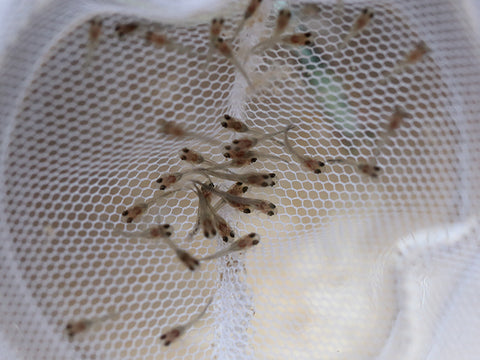Caring for African Dwarf Frogs
African Dwarf Frogs are some of the most popular additions to tanks. These little frogs are fully aquatic, so you don’t have to worry about a half aquatic and half terrain aquarium. African Dwarf Frogs will actually die outside of the water.
The frogs are bottom scavengers and are a fantastic choice for kids or controlling your fry population. If you have too many fry guppies in a tank, add some African Dwarf Frogs and they’ll eat guppy fry to ease the population. But, if you aren’t using them to control a guppy population, these frogs can be more difficult to feed.

African Dwarf Frogs are finicky eaters, but we have compiled a mini-guide on how to keep your aquatic buddies in top shape with full bellies. In this article, we will explore some feeding tips and characteristics of African Dwarf Frogs.
Feeding Dwarf Frogs
As mentioned above, African Dwarf Frogs are difficult to feed because they are finicky eaters but on top of that, they are slow eaters and cannot compete with fish. One problem that aquarium owners face with African Dwarf Frogs is that their food source needs to be able to stay in the water for a longer period of time without disintegrating. As the dwarf frogs are slow eaters, they may choose to return to a food source at a later time to grab another bite.
The best food options for African Dwarf Frogs are to feed them either frozen bloodworms or live black worms. Frozen bloodworms are the more commonly known food source but are an excellent choice when it comes to feeding your aquatic critters. Frozen bloodworms will not disintegrate in a short time span, ensuring that your frogs can feast at their leisure. You can use freeze dried bloodworms as an alternative but the issue with dried bloodworms is that they tend to float on the surface whereas frozen bloodworms drop to the bottom as they defrost. If you don’t want to have to provide food every day, live black worms may be the better choice.
Blackworms are the less common food choice for African Dwarf Frogs, but they pack their own set of great benefits. You can usually purchase a portion of black worms from your local fish store. These worms are a longer lasting food source because they are live and will bury themselves in your tank’s gravel. This gives them the ability to live inside your tank and be a constant food source for your hungry frogs.
African Dwarf Frogs feed by grabbing and pulling the worms into their mouth with a jerking motion. The way the blackworms move will encourage your frogs to eat them and if you have any docile fish in the tank, they will enjoy a snack as well. Blackworms are also an excellent choice for your frog’s food source because they pack high levels of protein. The higher the protein, the easier it is to keep your frogs fat and healthy.

Both frozen blood worms and black worms are a high-quality food source. It is best to give your frogs high-quality food because it will keep them happier and the tank cleaner. Often these frogs will be sold in other places outside of pet stores, like mall kiosks, where they are advertised as living in a small aquarium. The smaller the aquarium is, the less space there is for waste to disperse. A higher concentration of waste means less healthy animals and more time cleaning the tank. By investing in a larger tank and high-quality food, your animals will live healthier and happier lives.
One food source that isn’t recommended is food pellets. As mentioned, the African Dwarf Frogs are slow eaters and pellets dissolve in water rapidly. Your frogs will have less time to enjoy their meal before a pellet becomes to disintegrated to eat. As well, disintegrating pellets means more unnecessary waste for your tank. However, if you do choose to feed your African Dwarf Frogs pellets, it is best to place the pellets in a petri dish inside the tank. This way if the pellets do disintegrate, they are less like to disperse throughout the tank or become lodged in the gravel.
African Dwarf Frog Behavior
One important note to add is the common behavior of African Dwarf Frogs that usually has owners concerned. Many people will express worry for their frogs when they see them hugging each other and not moving for up to a day and a half. This is a normal behavior for the frogs and indicates that they are mating. Female African Dwarf Frogs are wider, whereas the males are skinnier. If you see a smaller frog hugging a larger frog, there is no need to panic. The frogs are simply doing as nature calls.

If you are looking to help raise a few tadpoles, you should be sure you have the space to do so. As well, any fish that are in the tank with the frogs may pose a threat. While adult frogs may co-exist with docile fish easily, most fish will attempt to eat the frog eggs.
African Dwarf Frogs can be a great addition to your tank. If you are sure to feed them correctly, in no time you could have thriving and happy frogs living in your aquarium.




